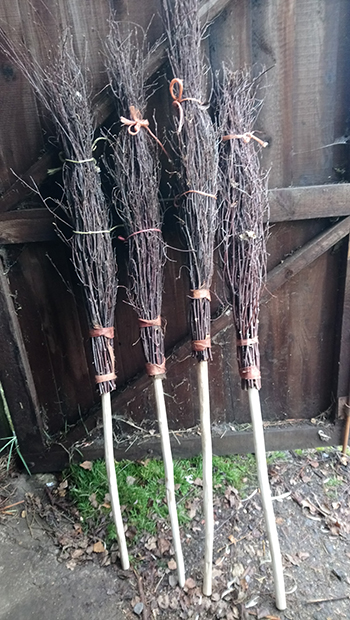
Early Wassledine besoms – ready for testing
Last August we spent a day on a training course making a hay rake and a besom broom in a lovely old wood near Hoddesden. It was a day run by the East Anglian Coppice Network which is part of the National Coppice Federation, and it was good just to spend time with people who, like us are trying to drag at least part of a living from the woods. There was as much chat as construction but then that was partly the point of the day – it’s good to hear how people are getting on, find out how their businesses are faring and see what ideas are out there to be pinched.
I’m usually on the lookout for new things to produce and sell; our charcoal has been doing well this summer but I knew from the start that making charcoal would involve a fair amount of hanging around. So, having another project to be getting on with whilst keeping half an eye on the charcoal, felt like a good idea.
Although the hay rake we came home with was pretty splendid – made with a hazel handle and ash head and tines – I’m yet to be persuaded that many people would find an obvious use for one in their gardens. But that’s not so true of a besom broom.
I think my dad had a besom when I was a kid, but until we made ours, I can’t think that I’ve ever picked one up, never mind used one. Here I should warn you in advance that I’m about to wax lyrical about a domestic cleaning tool; not my usual territory. I was a little surprised to discover just how much I liked the besom. I accept that it’s often a pleasure to use or look at something you’ve made yourself, but this was more than simple pride. This was a good tool – light weight, easy to use, far better than an ordinary brush to get into corners and tight spaces, great on grass, gravel, concrete… I did warn you! Anyway, if, I thought, I can get excited about using a besom, there surely must be others who would be thrilled with one. And not just any old one, but one made from hazel and sallow cut in Gravenhurst and birch from Maulden (both villages in Bedfordshire, UK, for those of you reading this in Jakarta).
I like a besom’s ancient origins and simplicity. A bunch of seasoned birch twigs is bound tightly with sallow bark (lots of other materials can be used – I just happen to have a lot of sallow available) to make the head, into which a seasoned, sharpened stake of hazel or sallow is driven to form the handle or tail. It couldn’t be much simpler. Of course, when one learns to do something new, it is much easier in the presence of the tutor. On my own, I’ve had plenty of false starts and failures, but that’s the way of learning. And of course, things that appear simple at first sight are often trickier in reality. But I have now produced a few besoms which might be getting towards being half decent.
Before I attempt to sell a besom to a real customer, I need to road test (or perhaps yard/workshop/lawn test) some. So I’m keeping the workshop far tidier than usual. Anyone who knows me and my habits would be shocked.
There, I managed to get through that without mentioning Harry Potter once…
.. ah darn it!
